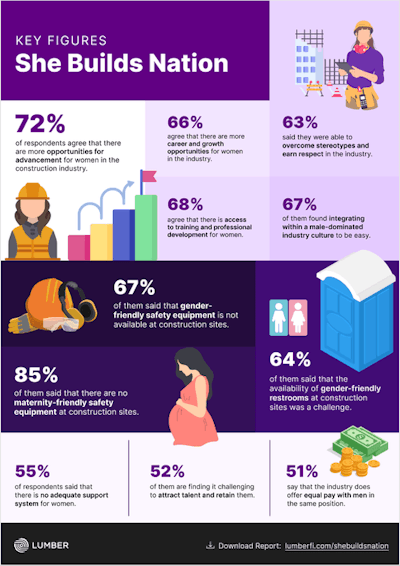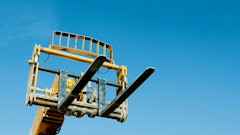
In celebration and recognition of Women in Construction Week during the first full week of March, Lumber conducted a "She Builds Nation" survey and has recently released the data in the report. The results showed a need for change within the industry. Women in construction are breaking down stereotypes and some are even rising through the ranks, but there is still a long way to go before women can be equally as safe and comfortable on the job site as their male counterparts. The following are the overall findings of this report.
Only 10% of women comprise the construction workforce, with 4% working onsite. While 67% of the women surveyed reported that they integrated into the industry somewhat smoothly and 72% revealed there were plenty of opportunities for them to advance, 67% of the women raised concerns about the lack of gender-friendly and maternity-friendly safety equipment. This poses a major problem when keeping women feeling safe and wanting to continue working in the industry.
President of LMS General Contractors, Jennifer Todd said "When discussing skilled tradeswomen—those on-site—endure a unique set of challenges. Women leave the construction field in part because they lack support at work. It’s not a construction issue, it’s a workplace culture issue. If the goal is to attract the next generation, the construction industry must shift from being project-centered to people-centered."
Women in the field are not considered when job sites are being set up and when getting supplies for the sites. Safety equipment is important for any worksite in the industry, but many companies are not supplying gender-specific equipment. Women often need gear that is made with a woman in mind as their bodies are not the same as men's. There are plenty of gender-specific gear options on the market but not enough companies are jumping up to bat with this. On top of this lack of safety equipment for women on construction sites, there is a profound lack of maternity equipment available on-site for those who need it.
"Often, companies have one-size-fits-all equipment for the workforce, including large men, petite women, women with curves, and all kinds of shapes and sizes. Recognizing these diverse needs, I've found that for small companies like mine, it's more practical to provide the workforce or subcontractor's team with an allowance to purchase PPE that fits them precisely. Rather than sharing equipment, this approach ensures a safer and more hygienic environment, " said Gloria Marie Fuentes, owner of GloJoy.  Lumber
Lumber
Adding to the struggle to find comfort in the industry, women usually have to share a portable toilet with everyone on site. The problem is that women need different things that men don't necessarily require. The cleanliness of the restroom and the access to toilet paper and a waste bin are very important for women whereas men don't entirely need these kinds of amenities. Women may need to take care of their menstrual cycle or those who are mothers may need a place to pump during the workday. These are things that companies are not considering that are vital for the comfort and hygiene of women in the industry.
Many of the decisions made for companies are cost-consciously made. Although it may cost more to buy women-specific and maternity-specific safety gear not in bulk, there are more important things to worry about. If a worker is not correctly protected because the gear doesn't fit them properly, they are at a much greater risk of injury on the job site.
When responding about topics of opportunities for career growth, equal pay, support systems, and attracting and retaining talent, those surveyed were relatively split on whether they agreed or not. This just shows that some companies are making good attempts to incorporate women into the workforce while others are seemingly ignoring their issues.
Something that needs to be considered by the industry is the extreme skilled labor shortage that it has been faced with and continues to grapple with. Women are an important part of the workforce and in order to draw them in and keep them, accommodations need to be met. Women's safety and comfort need to be taken into consideration and met with respect and professionalism.
You can download a copy of the full report here.

























